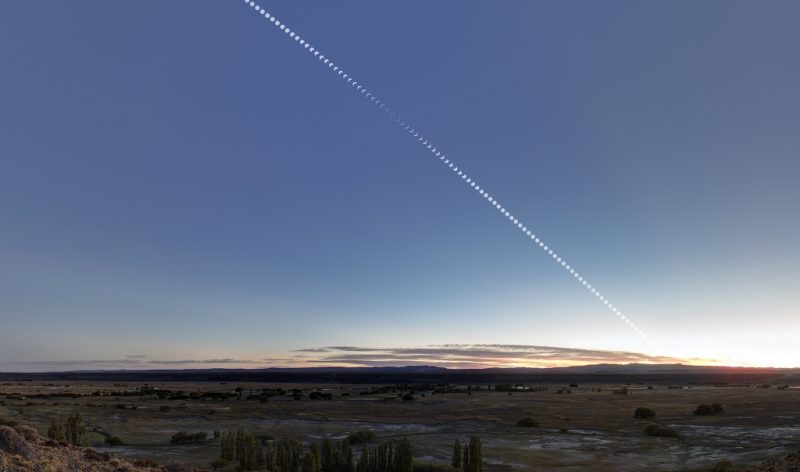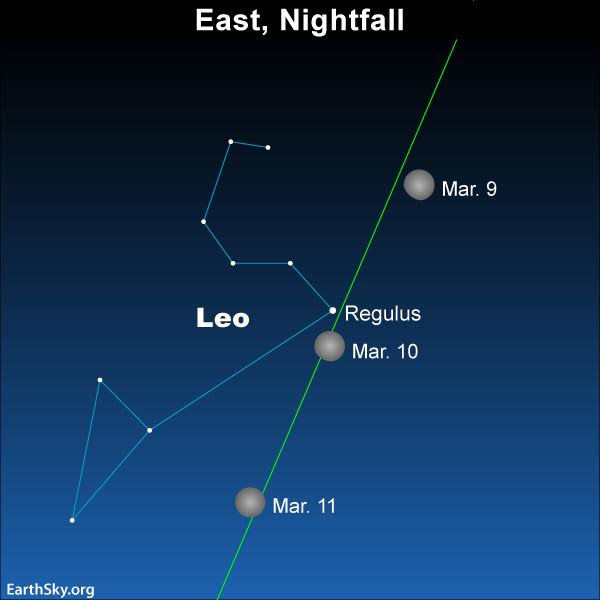Tonight – March 9, 2017 – a bright waxing gibbous moon lights up evening sky. Waxing means the moon’s illuminated phase is increasing; gibbous means the lunar disk now appears from Earth as more than half lit yet less than full. Click here to know what percentage of the moon’s face is covered over by sunshine right now.
The star close to the moon on this date is Regulus, brightest star in the constellation Leo the Lion. The green line depicts the ecliptic – Earth’s orbital plane projected onto the constellations of the zodiac. The moon will be moving through Leo in the next few evenings.
Because the moon’s orbit around Earth is an ellipse rather than a perfect circle, the moon’s distance from Earth varies throughout the month. For instance, in March 2017, the moon will swing farthest from Earth 251,437 miles (404,650 km) on March 18.
Then the moon will come closest to Earth – 226,087 miles (363,853 km) – on March 30. That’s a difference of about 25,000 miles (about 40,000 km), or about 3 Earth-diameters.
As the moon travels in front of the constellation Leo for the next several days, it’ll be at or near its mean distance from Earth. The moon’s mean distance (what astronomers call its semi-major axis) is 238,855 miles (384,400 km). Due to tidal fiction with Earth’s oceans, though, the moon’s mean distance is presently increasing at the rate of about 1.5 inches (3.8 cm) per year.
Additionally, the slowing of the Earth’s rotation is causing the day to lengthen by about 1 second every 40,000 years.
At one time, the moon was much closer to Earth and loomed much larger in Earth’s sky. It might have been as close as 9,000 miles (15,000 km, or just over one Earth-diameter) at its formation some 4.5 billion years ago.
What if the moon came closer? YouTube user yeti dynamics created the wonderful video below, showing what the moon would look like from Earth if it orbited us as the same distance as the International Space Station:
Whoa!
But – back to reality – the moon has never been that close, and it never will be.
And in fact, as mentioned above, the moon is moving away. At its closest in Earth’s early history – possibly 9,000 miles or 15,000 km – Earth was spinning much more rapidly than it is now. A day on Earth, a single cycle of light and dark, might have been only 6 hours long. How do we know? The evidence comes from Earth itself. For example, here’s one study, of tidalites in Australia and the United States, that enabled scientists to figure out that there were about 480 18-hour days in a year some 900 million years ago.
In the distant past, when the moon was significantly closer to Earth, total solar eclipses were more common than they are at present.
In the distant future, around a billion years from now, total solar eclipses will become a thing of the past.
We’re in the transitional period right now because annular solar eclipses – when the moon is too far away in its orbit to cover the sun completely, and an outer rim of the sun appears around the moon at mid-eclipse – actually outnumber total solar eclipses in our day and age.


Bottom line: On March 9, 2017, the moon is preparing to spend several days traversing the constellation Leo. Notice our moon, and Leo’s stars, and contemplate the Earth and moon’s long and varied history.












